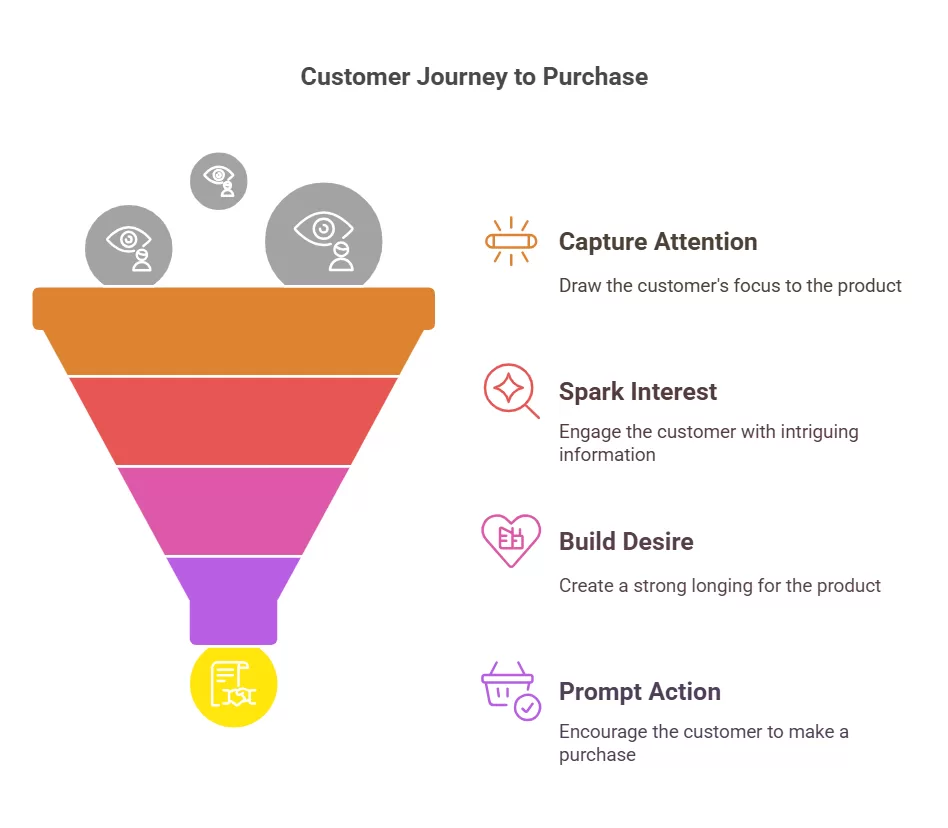The AIDA marketing model is a time-tested framework that has guided marketing strategies for decades. This model outlines the four crucial stages a customer goes through on their path to making a purchase: Attention, Interest, Desire, and Action. By deeply understanding and effectively implementing the AIDA principles, you can create marketing campaigns that resonate powerfully with your target audience and drive meaningful business results.
In this comprehensive guide, we’ll explore the origins of the AIDA model, dive into its key components, and examine real-world examples of how leading companies like Netflix and automotive brands apply this framework. Whether you’re a seasoned marketing professional or just beginning your journey, this blog post will equip you with the knowledge and insights to unlock the full potential of the AIDA model.
What is the AIDA Marketing Model?
The AIDA model is a classic marketing framework that describes the step-by-step journey a potential customer goes through before making a purchasing decision. The four stages of the AIDA model are:
- Attention – Capturing the customer’s initial attention and making them aware of your product or service.
- Interest – Piquing the customer’s interest and encouraging them to learn more about what you have to offer.
- Desire – Cultivating a strong desire within the customer to own or experience your product.
- Action – Prompting the customer to take the final step and convert by making a purchase.
The AIDA model is often visualized as a funnel, with the broadest stage of Attention at the top, and the narrowest stage of Action at the bottom. As customers progress through each stage, the number of potential buyers typically decreases, but their level of engagement and intent to purchase increases.

Key Principles of the AIDA Model
- Attention: The first and most crucial step is to capture the customer’s attention and make them aware of your product or service. This can be achieved through various marketing tactics, such as eye-catching advertising, engaging social media campaigns, or strategic search engine optimization (SEO).
- Interest: Once you have the customer’s attention, the next step is to spark their interest and encourage them to learn more. Provide informative content, highlight unique features, and demonstrate the tangible benefits of your offering to pique their curiosity.
- Desire: The goal at this stage is to cultivate a strong desire within the customer to own or experience your product. Tactics like showcasing social proof, emphasizing the product’s capabilities, and evoking emotional connections can help drive this desire.
- Action: The final stage is to prompt the customer to take the desired action, which is typically making a purchase. Utilize clear calls-to-action, streamlined checkout processes, and address any remaining objections to guide the customer towards this conversion.
Real-World Examples of the AIDA Model in Action
Netflix and the AIDA Marketing Model
Netflix is a prime example of a company that masterfully applies the AIDA model in its marketing strategy. Here’s a closer look at how Netflix leverages the four stages of the AIDA framework:
Attention: Netflix uses targeted advertising, engaging social media campaigns, and strategic search engine optimization to capture the attention of potential subscribers.
Interest: Once a customer is aware of Netflix, the company piques their interest by highlighting its vast content library, personalized recommendations, and user-friendly interface.
Desire: Netflix cultivates a strong desire for its service by emphasizing the convenience of on-demand streaming, the ability to watch anytime and anywhere, and the quality of its original content.
Action: Finally, Netflix makes it easy for customers to take action and subscribe, with a simple sign-up process and flexible pricing plans.
AIDA in Automotive Marketing
The automotive industry is another sector that extensively utilizes the AIDA model. For example, when launching a new car model:
Attention: Automakers may use eye-catching commercials, engaging social media campaigns, and prominent placements at auto shows to capture the attention of potential buyers.
Interest: They then provide detailed information about the car’s features, performance, and technology to pique the interest of customers.
Desire: Automakers often highlight the emotional appeal of the vehicle, such as its sleek design, luxurious interior, or exhilarating driving experience, to cultivate a strong desire among buyers.
Action: Finally, they make it easy for customers to take action by offering test drives, streamlined purchase processes, and financing options.
Comparison Chart: AIDA Marketing Model for New Customer Acquisition vs. Returning Customers
| Aspect | New Customer Acquisition | Returning Customers |
| Focus | Awareness and education | Loyalty and retention |
| Attention | Create awareness and grab attention of new prospects through bold visuals, targeted ads, and SEO strategies. | Re-establish communication and remind customers of the brand using personalized emails or retargeting campaigns. |
| Interest | Build curiosity by explaining your offering with informative content, videos, and USPs. | Rekindle interest by showcasing new products, features, or updates relevant to their preferences. |
| Desire | Highlight the product’s value through testimonials, limited-time offers, and addressing pain points. | Deepen emotional connection with exclusive offers, personalized recommendations, and customer success stories. |
| Action | Encourage first purchase with compelling CTAs, simplified checkout, and first-time buyer incentives. | Drive repeat purchases with reordering options, VIP programs, and loyalty rewards. |
| Messaging | Introductory and persuasive tone to explain benefits and uniqueness of the brand. | Relationship-driven and personalized tone to maintain engagement and appreciation. |
| Channels | Broad reach through advertisements, PPC, and social media campaigns. | Direct engagement via email campaigns, loyalty apps, and retargeting. |
| Offers | Discounts or incentives for first-time buyers to reduce purchase hesitancy. | Exclusive deals, rewards, or bundle options tailored to loyal customers. |
| Pain Points Addressed | Focus on educating and solving initial doubts about the brand or product. | Address dissatisfaction, disengagement, or lack of new offerings for loyal customers. |
| Long-Term Goals | Build awareness and convert prospects into first-time customers. | Foster loyalty, increase customer lifetime value, and encourage advocacy. |
The AIDA marketing model is a powerful framework that has stood the test of time, guiding marketers in their efforts to attract, engage, and convert customers. By deeply understanding and effectively implementing the AIDA principles, you can create marketing campaigns that resonate with your target audience and drive meaningful business results.
Remember, the key to success is not just in understanding the AIDA Marketing Model, but in continuously adapting and refining your marketing strategies to meet the evolving needs and expectations of your customers. Embrace the AIDA framework as a foundation, but be willing to experiment and innovate to stay ahead of the curve.
Knowing your customer is gives us the way to define the buyer persona, which is a very crucial step in making the marketing strategy. Read Buyer Persona Brand Development Guide also learn about the tools used in creating buyer persona and marketing content Read the ultimate guide to free ai tools for marketing
Ready to unlock the full potential of the AIDA Marketing Model? Start by exploring the additional resources provided and applying these principles to your own marketing endeavors. With the right strategy and execution, the AIDA model can be your guide to marketing excellence.






